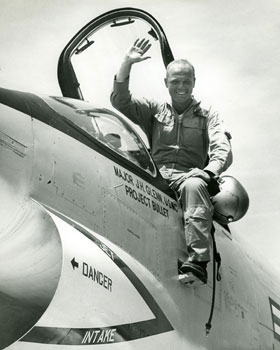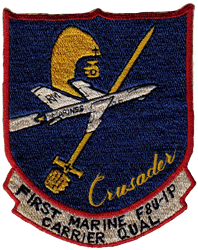MCARA Aircraft > F8U-1P/RF-8A Crusader
The F8U-1P was the unarmed photographic reconnaissance version of the F8U-1 fighter. The F8U-1P differed from the F8U-1 in having the lower half of the forward fuselage squared off to enable the installation of three CAX-12 trimetrogen cameras and two K-17 vertical cameras. To accommodate for the increased cross-sectional area resulting from the introduction of the camera bay, the upper portion of the fuselage was area ruled, resulting in a slight "hump" in the fuselage just above the wing leading edge. Photo-flash bombs for night photography could be carried internally. The internal cannon, the rocket pack, and the fire control radar were all removed. The blister on the port fuselage side was eliminated, since the air-refueling boom retracted flush with the fuselage. The horizontal tail was reduced to increase the aircraft's speed. The engine was the same J57-P-4A which powered the F8U-1.
The original suite of cameras included three trimetrogen cameras, which gave horizon-to-horizon coverate at Station 2, actually the aft-most bay. Eventually, the definitive camera arrangement was two cameras giving vertical and oblique in station s 3 and 4, while station 1, located below and forward of the cockpit, mounted a forward-looking oblique camera. Station 1 could also carry a 16-mm movie camera. Although the cameras at Stations 3 and 4 could give several degrees of obliquity, those most commonly used were 5 degrees, 15 degrees, and 30 degrees. The cameras were manufactured by Chicago Aerial and were designated KA-66 (station 2), KA-51, KA-53 or KA-62 (stations 3 and 4) and KA-45 or KA-51 (staion 1).
The first F8U-1P flew on December 17, 1956. All 3 VMCJs flew this plane and including J-1 in Vietnam. The last RF8As on active service left VMCJ-1 in late October 1966 but the reserve squadron VMJ-4 continued to fly the RF-8As and later RF-8Gs until the mid 1970s.
 In July of 1957, an attempt was planned to break the coast-to-coast speed record from California to New York. A F8U-1P (BuNo 144608) flown by then Marine Corps Major John H. Glenn would fly across the entire United States, using its cameras to photograph the terrain along his route. He would be escorted by Navy Lt Charles Demmler in an F8U-1. The flight was named Project Bullet and was to be supported by AJ-2 Savage aerial tankers. On July 16, the two Crusaders took off from Los Angeles. Lt. Demmler damaged his refuelling probe during a refuelling rendezvous over Albuquerque, New Mexico and was forced to land, but Major Glenn pushed on. He landed at Floyd Bennett Field in New York, with an average speed of 725.25 mph. For this feat, Major Glenn was awarded the Distinguished Flying Cross. Major Glenn was destined to go on to even greater fame. Shortly after his flight, he appeared on the TV quiz program "Name That Tune". He later become one of the seven Mercury astronauts and would be the first American to orbit the Earth. After leaving NASA, he became a Senator from Ohio.
In July of 1957, an attempt was planned to break the coast-to-coast speed record from California to New York. A F8U-1P (BuNo 144608) flown by then Marine Corps Major John H. Glenn would fly across the entire United States, using its cameras to photograph the terrain along his route. He would be escorted by Navy Lt Charles Demmler in an F8U-1. The flight was named Project Bullet and was to be supported by AJ-2 Savage aerial tankers. On July 16, the two Crusaders took off from Los Angeles. Lt. Demmler damaged his refuelling probe during a refuelling rendezvous over Albuquerque, New Mexico and was forced to land, but Major Glenn pushed on. He landed at Floyd Bennett Field in New York, with an average speed of 725.25 mph. For this feat, Major Glenn was awarded the Distinguished Flying Cross. Major Glenn was destined to go on to even greater fame. Shortly after his flight, he appeared on the TV quiz program "Name That Tune". He later become one of the seven Mercury astronauts and would be the first American to orbit the Earth. After leaving NASA, he became a Senator from Ohio.
The first reconnaissance Crusaders were delivered in September 1957 to VFP-61, which took the planes aboard the USS Midway before the end of the year. The last of 144 examples was delivered early in 1960.
In September of 1962, the F8U-1P was redesignated RF-8A in accordance with the new Tri-Service unified designation system.
It was to be in the Cuban missile crisis of October 1962 that the RF-8A was to prove its worth. Florida-based RF-8As of VFP-62 were to fly repeated missions over Soviet missile sites that were in preparation on the island of Cuba, providing evidence of their existence and monitoring the progress of their crews in getting them operational. Code-named Blue Moon, these flights began on October 23. Two flights were made daily from NAS Key West, with low-level high-speed dashes being made over Cuba. They returned to NAS Jacksonville, where their film was downloaded. They then returned to Cecil Field for maintenance, and then back to Key West for the next missions. For their aid in monitoring the Soviet missile buildup on Cuba, President Kennedy awarded a Navy Unit Commendation to VFP-62 on November 26, 1962.
 VFP-62 did not have enough RF-8As to meet the demanding Blue Moon flight schedule so they requested augmentation by 4 VMCJ-2 aircraft. The 2nd Marine Aircraft Wing commander advised the Navy that they would get the 4 RF-8As but they would come with Marine pilots! The four VMCJ-2 RF-8As were updated with the latest Chicago Aerial forward firing panoramic cameras with image motion compensation by a contractor team just days before joining VFP-62 in Key West. Perhaps the most memorial moment on the Cuban Missile Crisis was on 25 October when our UN ambassador showed the low level pictures of the near operational missile sites to the Soviets and the world on TV. The four Marine pilots, Captains E.J. Love, John Hudson, Dick Conway and Fred Carolan received DFCs for their missions along with their Navy counterparts and also shared in the VFP-62 Navy Unit Commendation. VMCJ-2 received its own Navy Unit Commendation for its photo and electronic reconnaissance operations against Cuba from September 1960 until December 1962.
VFP-62 did not have enough RF-8As to meet the demanding Blue Moon flight schedule so they requested augmentation by 4 VMCJ-2 aircraft. The 2nd Marine Aircraft Wing commander advised the Navy that they would get the 4 RF-8As but they would come with Marine pilots! The four VMCJ-2 RF-8As were updated with the latest Chicago Aerial forward firing panoramic cameras with image motion compensation by a contractor team just days before joining VFP-62 in Key West. Perhaps the most memorial moment on the Cuban Missile Crisis was on 25 October when our UN ambassador showed the low level pictures of the near operational missile sites to the Soviets and the world on TV. The four Marine pilots, Captains E.J. Love, John Hudson, Dick Conway and Fred Carolan received DFCs for their missions along with their Navy counterparts and also shared in the VFP-62 Navy Unit Commendation. VMCJ-2 received its own Navy Unit Commendation for its photo and electronic reconnaissance operations against Cuba from September 1960 until December 1962.
In Vietnam, the RF-8A was to provide valuable reconnaissance data during that unfortunate conflict, many being lost to North Vietnamese AAA during dangerous low-altitude overflights.
 In 1963, five RF-8As were fitted with ventral fins and strengthened wings, In 1965-66, a conversion program was carried out for the modernization of 73 RF-8As, which were returned to the manufacturer for addition of strengthened wings, wing pylons, ventral fins, fuselage structural reinforcements, uprated J57-P-22 or P-420 engines, and a new electrical system. A new navigation system and provision for improved cameras was made. These modified RF-8As were redesignated RF-8G.
In 1963, five RF-8As were fitted with ventral fins and strengthened wings, In 1965-66, a conversion program was carried out for the modernization of 73 RF-8As, which were returned to the manufacturer for addition of strengthened wings, wing pylons, ventral fins, fuselage structural reinforcements, uprated J57-P-22 or P-420 engines, and a new electrical system. A new navigation system and provision for improved cameras was made. These modified RF-8As were redesignated RF-8G.
Major Glenn's Project Bullet F8U-1P BuNo 144608 continued flying after his record speed run and was eventually remanufactured as an RF-8G. It was lost in December of 1972 when it struck the flight deck of the carrier Oriskany (CV-34) and its pilot ejected.
 Specifications:
Specifications:
WING SPAN - 35’ 8”
WING AREA - 375 SQ FT
LENGTH - 54’ 3”
HEIGHT - 15’ 9 ”
GROSS TAKE OFF WEIGHT - 27,822 LBS
ENGINE - PRATT & WHITNEY J57-P-4A
THRUST - 10,200 LBS - 16,000 LBS WITH AFTERBURNER
MAX SPEED - 983 MPH
CEILING - 51,800’
RANGE - 2,000 NAUTICAL MILES
ARMAMENT - CAMERAS


